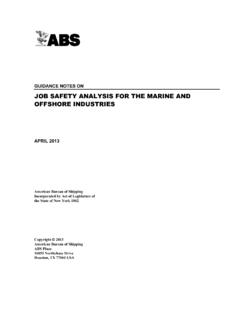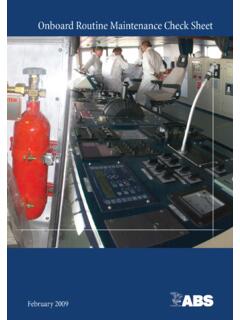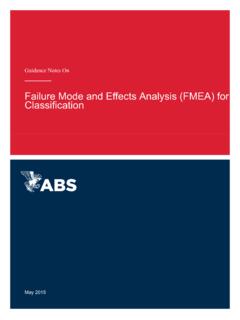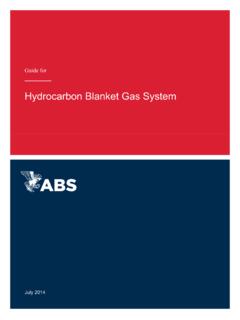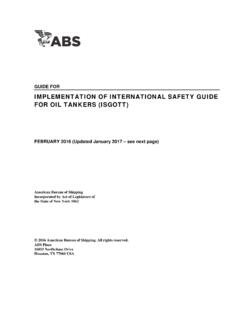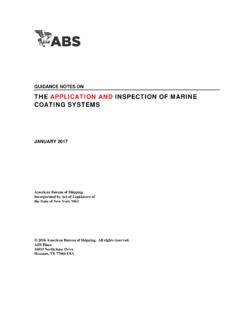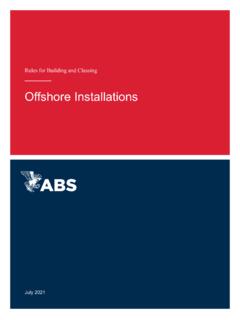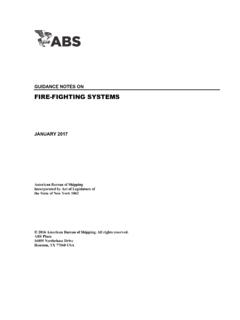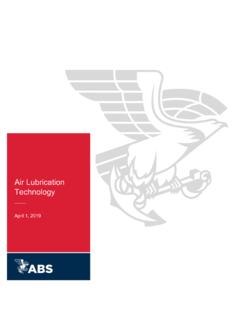Transcription of Guide for Ballast Water Exchange
1 Guide FOR. Ballast Water Exchange . JUNE 2020. American Bureau of Shipping Incorporated by Act of Legislature of the State of New York 1862. 2020 American Bureau of Shipping. All rights reserved. 1701 City Plaza Drive Spring, TX 77389 USA. Foreword (1 June 2020). The inadvertent transfer of harmful aquatic organisms and pathogens in a vessel's Ballast Water has been determined to have caused a significant adverse impact to many of the world's coastal regions. The international maritime community, under the auspices of the International Maritime Organization (IMO). has developed several documents, including the International convention for the Control and management of Ship's Ballast Water and Sediment, 2004, ( Ballast Water management convention ), which are aimed at preventing the introduction of unwanted aquatic organisms and pathogens through the discharge of Ballast Water and sediments.
2 The Ballast Water management convention applies to vessels registered in a country which is party to the convention and to those vessels registered in other countries when operating in the waters of a country which is party to the convention . One of the strategies incorporated into the Ballast Water management convention is Ballast Water Exchange (BWE). Ballast Water Exchange is the process of exchanging coastal Water , which may be fresh Water , salt Water or brackish Water , for mid-ocean Water . During the Exchange process, biologically laden Water taken on in the last port of call is flushed out of the Ballast tanks with open ocean Water , typically 200 nautical miles from the nearest land.
3 Scientists, specifically Marine Biologists, have determined that marine organisms and pathogens are, in general, less numerous in the open ocean and, due to changes in the Water 's chemistry, temperature and salinity would be less likely to survive once they are discharged into the near shore receiving waters. While the vast majority of vessels are capable of conducting Ballast Water Exchange , and the procedures do not typically require any special structural modifications to most of the vessels in operation, it does present challenges for designers, builders, owners and operators. These challenges include over-pressurization or under-pressurization of tanks, longitudinal strength and transverse stability concerns, as well as maneuverability issues.
4 To assist the marine industry, ABS issued the Advisory Notes on Ballast Water Exchange Procedures in October 1999. This Advisory described the implications associated with Ballast Water management and Ballast Water Exchange using fourteen typical vessels as examples. While the findings contained in the Advisory focused on existing vessels, many of the conclusions could also be applied to assist in the development of new buildings. However, it is to be noted that the details provided in the Advisory are vessel-specific and that the information contained therein was to be viewed as typical, and provide representative values that might be obtained for any single vessel and are highly dependent on the vessel's design and structure, which may vary greatly from one vessel to another.
5 This Guide for Ballast Water Exchange is provided for the use of designers, builders, owners, and operators of vessels classed with ABS and specifies the requirements for obtaining the optional classification notation Ballast Water Exchange (BWE). The BWE notation identifies a level of compliance with the applicable regulations contained in the IMO International convention for the Control and management of Ships' Ballast Water and Sediments, 2004 , as well as those IMO Guidelines referenced in the convention addressing Ballast Water Exchange . The June 2020 edition includes references to contingency measures developed by the Committee, updates IMO/MEPC resolutions, and incorporates amendments to regulation B-3 (Implementation schedule).
6 It also adds requirements for Offshore Units for assessment with approved operation manuals and AVCG. curve, and deletes redundant text copied from BWM convention and resolution (20). The convention has entered into force and many port States such as Brazil, Canada and the United States have established national regulations mandating the Exchange of Ballast Water , together with evidence to support that the Exchange has taken place ( Ballast Water records). This Guide is to be used in conjunction with other Rules published by ABS and IMO guidelines. ABS Guide FOR Ballast Water Exchange 2020 ii Users of this Guide acknowledge and agree that ABS is not responsible for a vessel's operation pertaining to Ballast Water Exchange and shall bear no liability for such operations.
7 This Guide references relevant international regulations and guidelines that are considered to be applicable. While it is the intent of the Guide to be consistent with these relevant regulations and guidelines, it is the ultimate responsibility of the users of this Guide to refer to the most recent text of those regulation and guidelines. ABS appreciates the receipt of comments and suggestions, as well as technical and application questions for the improvement of this Guide . Users are also advised to check with ABS to verify that this version of the Guide is current. For this purpose, enquiries can be submitted electronically to either or to the Rules & Guides Section of The effective date of this Guide is the first day of the month of publication.
8 ABS Guide FOR Ballast Water Exchange 2020 iii Guide FOR. Ballast Water Exchange . CONTENTS. CHAPTER 1 1. Section 1 2. Section 2 4. Section 3 Basis of Section 4 Classification Symbol and 6. Section 5 Classification 7. CHAPTER 2 Ballast Water Exchange 9. Section 1 Ballast Water Exchange Standard and Requirements ..10. Section 2 Ballast Water Exchange Section 3 Ballast Water Exchange System Design and CHAPTER 3 Ballast Water management Section 1 General 26. Section 2 Cover Section 3 28. Section 4 29. Section 5 Vessel 30. Section 6 Crew Review Record/Revision 31. Section 7 Table of Section 8 Introduction - Intent and Purpose of Ballast Water management and management Section 9 Ballast Water System Drawings and 35.
9 Section 10 Ballast Water Sampling Section 11 Operational Section 12 Safety Procedures for the Vessel and 42. Section 13 Operational or Safety Restrictions .. 43. Section 14 Description of the Method(s) Used Onboard for Ballast Water management and Sediment Control ..44. Section 15 Procedures for the Disposal of 46. Section 16 Methods of 47. Section 17 Duties of Designated Ballast Water management Officer and Vessel's 48. Section 18 Ballast Water Record Book and Reporting Forms .. 50. ABS Guide FOR Ballast Water Exchange 2020 iv Section 19 Crew Training and 52. Section 20 Supporting 53. APPENDIX 1 .. 54. Section 1 Ballast Water Reporting Section 2 Ballast Water 59.
10 ABS Guide FOR Ballast Water Exchange 2020 v CHAPTER 1 Introduction CONTENTS. SECTION 1 1 2. 3 Objective/Scope ..2. FIGURE 1 Scope of this SECTION 2 4. SECTION 3 Basis of 5. SECTION 4 Classification Symbol and 1 Systems Built under 3 Systems Not Built under 6. SECTION 5 Classification 1 Engineering 3 Initial 7. 5 Surveys After 7. 7 Governmental 8. ABS Guide FOR Ballast Water Exchange 2020 1. CHAPTER 1 Introduction SECTION 1 General 1 Application The requirements in this Guide apply to vessels that are designed, equipped and intended to conduct Ballast Water Exchange at sea in accordance with the International convention for the Control and management of Ships' Ballast Water and Sediments, 2004 , the associated IMO Guidelines and national regulations addressing Ballast Water Exchange .
